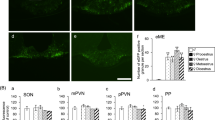Summary
Mating was used in the rabbit as a physiological trigger, easily definable in time, for the activation of gonadotropic hypothalamic structures. Using the histochemical fluorescence technique of Falck and Hillarp, it has been attempted to determine whether, in relation to mating, clearly distinguishable and reproducible changes in histofluorescence occur in the tubero-infundibular dopaminergic system in combination with hypothalamic hypophysiotropic hormone release.
Between 20–30 min post-coitum an increase in DA turnover was noted in the external layer of the median eminence. The characteristics of this reaction were studied by administration of reserpine andα-methyl-paratyrosine. Immediately after coitus, a paradoxical fluorescence reactivation was observed in the median eminence in female rabbits in which tyrosine-hydroxylase activity was inhibited for 5 hours.
Similar content being viewed by others
Abbreviations
- DA:
-
Dopamine
- TIDA:
-
tubero-infundibular-dopaminergic complex
References
Ahren, K., K. Fuxe, L. Hamberger, andT. Hökfelt: Turnover changes in the tubero-mfundibular dopamine neurons during the ovarian cycle of the rat. Endocrinology88, 1415–1424 (1971).
Bensch, Cl., andP. L'Hermite: Etude par la microscopie de fluorescence de la région médiane de l'hypothalamus de la lapine. Changements constatés après coït. C.R. Acad. Sciences (Paris)D 269, 2560–2563 (1969).
Björklund, A., B. Falck, andCh. Owman: Fluorescence microscopic and microspectrofluorometric techniques for the cellular localization and characterization of biogenic amines. In: Methods in Investigative and Diagnostic Endocrinology, Vol. I: The thyroid and biogenic amines (Rall, J. E., andI. J. Kopin, eds.), pp. 318–368. Amsterdam-London: North-Holland Publishing Company. 1972.
Carlsson, A.: Pharmacological depletion of catecholamine stores. Pharmacol. Rev.18, 1. 541–549 (1966).
Davson, H.: The blood-brain barrier. In: The Structure and Function of Nervous Tissue (Bourne, G. H., ed.), Vol. IV, pp. 321–445. New York-London: Academic Press. 1972.
Dempsey, E. W., andG. B. Wislocki: Electron microscopic study of blood-brain barrier in rat, employing silver nitrate as vital stain. J. Biophys. Biochem. Cytol.1, 245–256 (1955).
Falck, B., andCh. Owman: A detailed methodological description of the fluorescence method for the cellular demonstration of biogenic amines. Acta Univ. Lundensis, SectionII, Nr. 7, pp. 1–23. Lund: Gleerup. 1965.
Fuxe, K.: Cellular localization of monoamines in the median eminence and the infundibular stem of some mammals. Z. Zellforsch.61, 710–724 (1964).
Fuxe, K.: Evidence for the existence of monoamine neurons in the central nervous system. III. The monoamine nerve terminal. Z. Zellforsch.65, 573–596 (1965 a).
Fuxe, K.: Evidence for the existence of monoamine neurons in the central nervous system. IV. The distribution of monoamine nerve terminals in the central nervous system. Acta Physiol. Scand.64, Suppl. 247, 39 to 85 (1965 b).
Fuxe, K., andT. Hökfelt: Catecholamines in the hypothalamus and the pituitary gland. In: Frontiers in Neuroendocrinology (Ganong, W. F., andL. Martini, eds.), pp. 47–96. New York-London-Toronto: Oxford University Press. 1969.
Fuxe, K., T. Hökfelt, G. Jonsson, andU. Ungerstedt: Fluorescence microscopy in neuroanatomy. In: Contemporary Research Methods in Neuroanatomy (Nauta, W. J. H., andS. O. E. Ebbeson, eds.), pp. 275–314. New York-Heidelberg-Berlin: Springer. 1970.
Fuxe, K., T. Hökfelt, C. D. Sundstedt, K. Ahren, andL. Hamberger: Amine turnover changes in the tubero infundibular dopamine (DA) neurons in immature rats injected with PMS. Neuroendocrinology10, 282–300 (1972).
Glowinski, J., M. J. Besson, A. Cheramy, F. Javoy, andA. M. Thierry: Caractéristiques et fonctions des compartiments intraneuronaux des monoamines dans le système nerveux central. In: Les Médiateurs Chimiques—XXIXe. Réunion neurolologique internationale, pp. 1–22. Paris: Masson. 1972.
Halász, B.: Hypothalamic mechanisms controlling pituitary function. In: Topics in Neuroendocrinology (Ariëns Kappers, J., andJ. P. Schadé, eds.), pp. 97–122 (Progress in Brain Research, Vol. 38). Amsterdam-London-New York: Elsevier. 1972.
Hökfelt, T., andK. Fuxe: On the morphology and the neuroendocrine role of the hypothalamic catecholamine neurons. In: Brain-endocrine Interaction, Median Eminence: Structure and function. Int. Symp. Munich 1971 (Knigge, K. M., D. E. Scott, andA. Weindl, eds.), pp. 181–223. Basel: S. Karger. 1972.
Jonasson, J., E. Rosengren, andB. Waldeck: Effects of some pharmacologically active amines on the rupture of arylalkylamines by adrenal medullary granules. Acta Physiol. Scand.60, 136–140 (1964).
Kerkut, G. A.: Transport of glutamate to nerve terminals. Neurosci. Res. Program, Bull (U.S.A.)5, 322–325 (1967).
Kirschner, N., M. Rorie, andD. L. Kamin: Inhibition of dopamine uptake “in vitro” by reserpine administered “in vivo”. J. Pharmacol.141, 285–289 (1963).
Kopin, I. J.: Storage and metabolism of catecholamines: the role of monoamine oxidase. Pharmacol. Rev.16, 179–191 (1964).
Leonardelli, J.: Etude histoenzymologique de l'hypothalamus du cobaye. II. Détection de la monoamine oxydase chez le mâle et chez la femelle au cours du cycle oestral. C.R. Soc. Biologie (Paris)160, 2072–2075 (1966).
L'Hermite, P.: Capture et stockage des amines catéchiques par les fibres adrénergiques du système nerveux central et périphérique. I. Etude de la technique cytochimique de Falck. Archives d'Anatomie microscopique58, 203–218 (1969).
Salseduc, M. M., J. J. Jofre, andJ. A. Izquierdo: Monoamine-oxydase and Catechol-O-methyl-transferase activity in cerebral structures and sexual organs of rats during their sexual cycle. Med. Pharmacol. exptl.14, 113 (1966).
Sawyer, Ch. H.: Regulatory mechanisms of secretion of gonadotrqphic hormones. In: The Hypothalamus (Haymaker, W., E. Anderson, andW. J. H. Nauta, eds.), pp. 389–430. Springfield: Ch. C Thomas. 1969.
Ungerstedt, U.: Stereotaxic mapping of the monoamine pathways in the rat brain. Acta Physiol. Scand., Suppl.367, 1–48 (1971).
Zolovic, A. J., R. Pearse, K. W. Boehlke, andB. E. Eleftheriou: MAO activity in various parts of the rat brain during the estrous cycle. Science154, 649–650 (1966).
Author information
Authors and Affiliations
Additional information
This investigation was supported by grants from C.N.R.S. (Equipe de Recherche associée No. 493) and I.N.S.E.R.M. (C.R.L. No. 74.1.167,08). The authors gratefully acknowledge the technical assistance of Mrs. M. Cazalis, Mrs. R. Bonhomme, and M. Fl. Rodriguez.
Rights and permissions
About this article
Cite this article
Bensch, C., Lescure, H., Robert, J. et al. Catecholamine histofluorescence in the median eminence of female rabbits activated by mating. J. Neural Transmission 36, 1–18 (1975). https://doi.org/10.1007/BF01243433
Received:
Revised:
Issue Date:
DOI: https://doi.org/10.1007/BF01243433




